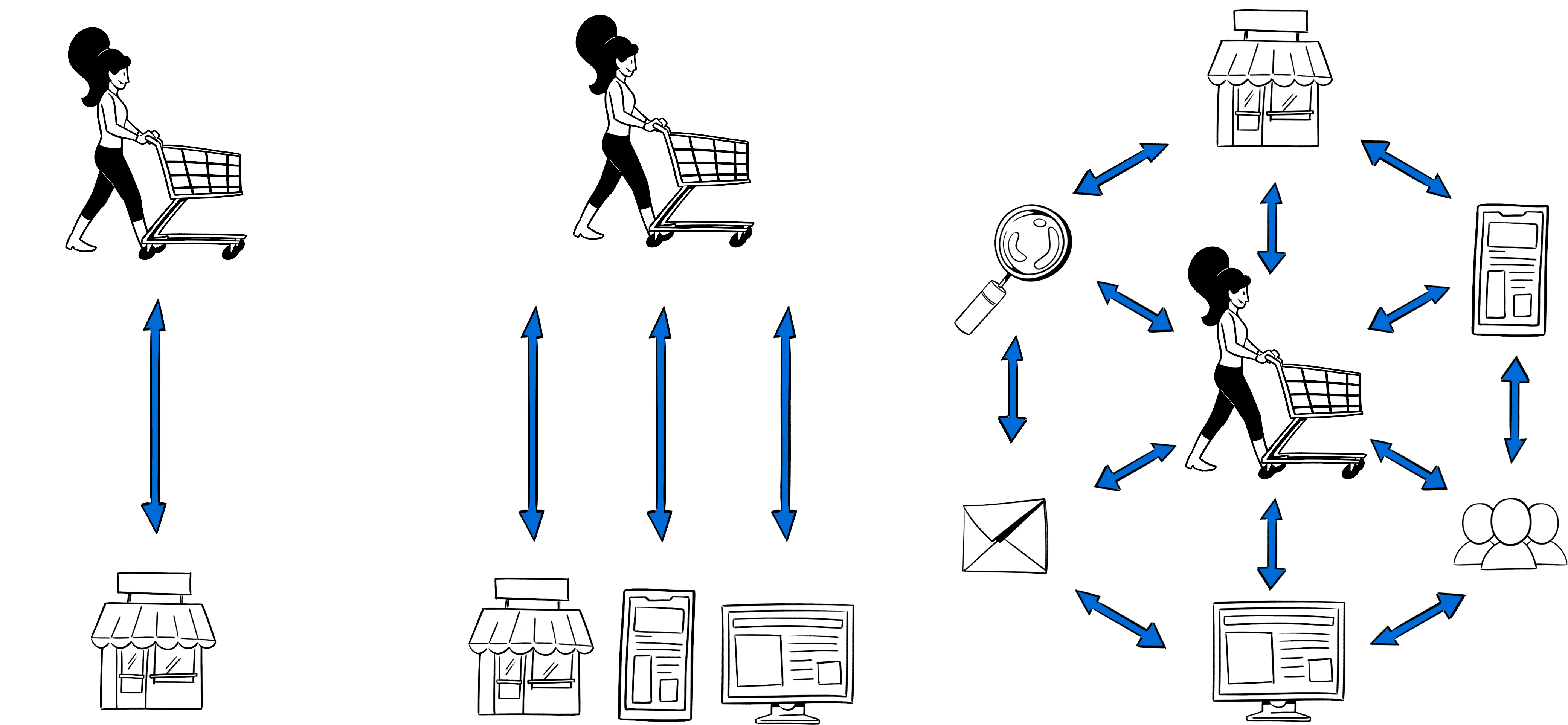The need for an omnichannel approach to analytics is hardly breaking news. The offline and online worlds are blending, paths leading to purchases are more of a “back and forth” story than a “one-time shot” and attribution is getting harder. And yet, gathering data from all channels and touchpoints remains a significant challenge. How do you tackle it?

Modern customers interact with brands through various channels. Their interactions can include website visits, mobile app usage, email checks, text messaging, social media browsing, magazine reading, and exposure to outdoor advertising like billboards.
The traditional four-stage customer journey model of awareness, consideration, purchase, and retention, while logical, is rarely followed by consumers.
Users frequently transition between different devices prior to finalizing their purchase, extending the shopping experience over time and making it unpredictable. According to Google, 90% of multiple device owners change devices to complete tasks, with an average of three different combinations of devices used every day.
Customers expect the shopping experience to be as easy and frictionless as possible. As the Gartner 2021 survey showed, creating positive customer experiences can have profound benefits for businesses:
- There’s a 97% chance that customers will spread their good experiences through word of mouth, boosting brand recognition and drawing in new clients.
- 86% of them are likely to spend more, suggesting greater value over the customer’s lifetime and a rise in revenue possibilities.
- There’s an 82% probability they will remain loyal customers, demonstrating the potential for fostering enduring loyalty and repeated transactions.
However, creating smooth customer experiences isn’t easy. Companies tend to struggle with data closed in silos and often lose the big picture while trying to analyze the information they’ve gathered.
These challenges have led omnichannel analytics to grow into one of the most promising solutions. Why? Because its goal is to provide customers with a seamless experience through their entire path to purchase, regardless of the channels they use.
What is omnichannel analytics?
Omnichannel analytics, the foundation of data-driven omnichannel marketing, relies on gathering customer data from all channels used by brands. It’s a customer-centric approach aiming to recreate users’ real paths to conversion, consolidate information from disparate sources and garner a full understanding of consumer actions.
By accessing a 360-degree view of what exactly made a client convert – to buy, send a demo request or register as a user – marketers gain a holistic picture of marketing performance. With that, they are able to evaluate their activities and effectively allocate budget.
Seems simple? In theory – yes. In practice, however, the omnichannel approach’s essence is often lost. Marketers tend to focus on multiplying separate channels and touchpoints rather than creating an ecosystem of seamless connections between them.
| Single-Channel | Multichannel | Omnichannel |
|---|---|---|
| An approach where a business reaches customers through only one distribution option, like online, face-to-face selling, or traditional retail. | An approach that combines different distribution options to be present when a purchase decision is made. Channels operate independently, offering distinct shopping experiences. | An approach that incorporates all possible touchpoints with a brand, regardless of the purchase point, focusing on integration and consistency across all channels. |
| Single distribution channel. | Multiple independent channels. | Integrating and maintaining consistency of customer experience across all channels. |
| Allows businesses to concentrate on refining one channel, particularly if resources are limited. | Offers flexibility with each channel operating independently. | Provides a seamless experience that focuses on all channels as a whole. |

Why is omnichannel analytics important?
Customers desire a seamless and homogeneous experience across all touchpoints, seeking comfort and loyalty that influence their future purchase decisions.
This isn’t just about securing a one-time sale; it’s about fostering long-term relationships through consistently positive experiences.
By utilizing comprehensive data from various channels, businesses are not confined to the limitations of simplistic attribution models, such as last-click or first-click. These models often fail to capture the full customer journey and don’t provide insights into the underlying motivations of the audience.
With omnichannel analytics, marketers gain a deeper understanding of user motivations, which is crucial for optimizing marketing strategies. This understanding allows them to concentrate resources on channels that drive sales rather than squandering budget on ineffective avenues.
The key lies in recognizing that maintaining and nurturing existing client relationships tends to be more cost-effective and productive than acquiring new ones. By focusing on long-term engagement and satisfaction through a well-integrated omnichannel approach, businesses can enhance customer retention, ultimately leading to sustained revenue growth and stronger brand loyalty.
And this is not just a hollow marketing statement:
- Existing customers also contribute significantly more to a company’s revenue, generating 65% of a company’s revenue compared to new customers, who bring in 35% (source: OnlineDasher)
- They are also 50% more likely to try new products and spend 31% more compared to new customers (source: Invesp)
- In the SaaS industry, it can cost four to five times more to acquire new customers versus retaining current ones (source: HRB)
What are the benefits of omnichannel analytics
Better insight into customer behavior
Omnichannel analytics provides a comprehensive view of customer interactions across various channels, enabling businesses to better understand their audience.
Predictive analytics
By analyzing data from multiple channels, businesses can predict customer behavior and make informed decisions. For example, they can optimize their inventory or logistics resources.
Improved engagement
Omnichannel analytics helps businesses identify the most effective channels for customer engagement and allocate resources accordingly, leading to higher customer satisfaction.
Improved personalization
By focusing on the right channels, businesses can create more experiences tailored to each channel. For example, they may craft more informal communications for TikTok or Instagram rather than targeting customers with the same average messaging at all touchpoints.
Consistent brand experience
Omnichannel analytics helps ensure that customers receive the same level of service and recognition, regardless of the platform they use.
Optimized marketing campaigns
By analyzing the performance of marketing campaigns across various channels, businesses can identify the most successful strategies and channels, leading to more effective marketing executions.
Sample use cases of omnichannel analytics
Healthcare
In the healthcare sector, omnichannel analytics could involve integrating various channels depending on the specific subset being covered. Typically, this can include physical locations, online platforms, mobile applications, and wearables.
By integrating experiences across physical and digital platforms, including mobile and desktop, healthcare provider companies could use omnichannel strategies to provide patients with easy access to health records and benefits such as electronic prescriptions and online doctor appointments.
With unified patient interaction data, healthcare providers can offer personalized patient care. For instance, if patients frequently search online for information about a specific health condition, they might receive tailored educational content or personalized check-up reminders.
By analyzing appointment booking data, healthcare providers can optimize physician schedules and reduce patient wait times in clinics and telehealth appointments.
Finance & Insurance
The finance and insurance industries are at the forefront of digitization, and thus, the integration of data from all channels – including transactions at branches, online banking activities, mobile app usage, and call center interactions – is fundamental to their operations.
With this integrated approach, finance companies can offer personalized financial advice and product recommendations. They can also improve service quality on both digital platforms and in branches and streamline sales processes by providing clients with a seamless experience. For example, if a customer begins a query in the mobile app but then calls a service center, the representative can immediately access the previous interaction, improving customer service quality.
Moreover, omnichannel analytics is fundamental to risk management and fraud detection. Comprehensive data is essential to effectively “feed” the AI and ML systems designed to identify unusual patterns in customer transactions.
Additionally, analyzing data from branch visits and ATM usage helps decision-makers optimize branch locations, ATM placements, and staffing requirements.
Ecommerce
Ecommerce businesses can integrate data from multiple channels such as online stores, mobile app usage, social media interactions, and customer service records.
The omnichannel approach is their answer to the limitations of traditional multichannel marketing tactics, which often failed to build customer loyalty.
Customers’ purchasing intentions often originate on social media before they visit the website, sometimes delaying their purchase decision.
A company can tailor messages to a given stage of the customer journey to sustain their interest. This may involve:
- Using targeted social media advertising on platforms like Facebook.
- Focusing on SEO to improve their products’ visibility and performance in search results.
- Implementing remarketing strategies to re-engage those who visited the website but did not make a purchase.
After a purchase, maintaining the customer relationship becomes vital. Companies can achieve it by integrating data from email and chat to create personalized mailings, including promotions, loyalty program invitations, and cross- or upselling offers.
Finally, analyzing sales and marketing data across channels supports predicting demand patterns, leading to efficient inventory management and reducing the risks of stockouts or excess inventory.
What tools can you use for omnichannel analytics
Customer data platforms (CDPs)
A customer data platform (CDP) is software that consolidates first-party customer data from various sources, including websites, mobile apps, email, and physical stores, to create comprehensive, up-to-date customer profiles.
The primary goal of a CDP is to enhance the effectiveness of marketing strategies by optimizing the timing and precision of messages, offers, and engagement activities through data activation. A CDP enables businesses to fine-tune their marketing and customer engagement strategies more effectively than traditional data management tools.
Customer Relationship Management (CRM) and Enterprise Resource Planning (ERP)
These systems provide a comprehensive view of customer interactions by integrating data across channels, including sales, marketing, and customer service. They facilitate better customer relationship management by consolidating information into a single framework.
Business Intelligence (BI) and data visualization tools
Business intelligence (BI) software utilizes APIs, automation, AI, and other tools to simplify the process of data compilation, organization, analysis, and visualization. Meanwhile, data visualization tools help create visual representations of large data sets. All these tools specialize in deep data analysis, offering critical insights by processing and presenting data from various points and channels.
Data analytics platforms
Data analytics tools are designed to analyze distinct aspects of the customer experience, such as purchase behavior or interactions with the product or website. They vary in their specific features, usability, and focus areas, allowing businesses to choose the one that best fits their unique data analysis needs and objectives.
When it comes to omnichannel analytics, one of the most optimal options is an integrated analytics platform. These platforms provide a more expansive range of analytical capabilities that extend beyond marketing use cases. They offer insights into operational efficiency, financial performance, and market trends, catering to various business intelligence needs.
Integrated analytics platforms offer seamless integrations of tools and data sources while providing you with features to effectively act on the analyzed data, letting you utilize them for a multitude of marketing, sales and business use cases.
How to choose the right tool for omnichannel analytics
As businesses grow, diversify their product lines, or enter new markets, the need for an extendable tool becomes critical. Such a tool should help them adapt to changes by incorporating new data sources, metrics, or advanced features like AI and ML as required. Importantly, it should integrate seamlessly with the existing infrastructure, enhancing it rather than necessitating re-platforming or redesigning data flows.
Scalability is equally crucial, especially as the volume of data requiring processing grows exponentially. A scalable tool is essential to handle this increasing volume efficiently and maintain performance standards.
In a data-centric world, security concerns are paramount, as any data breaches can lead to significant financial and reputational damage. That’s why the tool should adopt sufficient privacy and security measures.
In summary, extendability, scalability, and robust security are foundational elements for any business tool, especially in an era where data is a vital asset for business growth and innovation
A step-by-step process for implementing omnichannel analytics
Selecting a platform:
Begin by choosing a suitable platform. The market offers a wide variety of tools, so your choice should depend on your budget, objectives, and considerations for future scalability and integration capabilities. You must determine your data volume and sources, and assess your customization needs.
Integrating data sources:
After selecting the platform, connect your data to it. This process often involves integrating other tools, such as email software, social media channels, online advertising platforms, and more. Ensure that data quality and consistency are maintained during this integration.
Customizing your reports and dashboards:
Once connected, you will be able to use various reporting features to cater to your company’s needs. For example, you can create dashboards depicting specific channels, demographics, or customer segments. Customize them to align with your specific business objectives, whether that involves comparing trends, analyzing the impacts of ads, or examining product performance within a category.
Measuring key metrics:
Choose what metrics you want to track first. To simplify the process, consider starting with three main metrics: user engagement, attribution, and revenue. Understanding these is vital for advancing to more complex analyses, such as assessing lead quality and conversion rates. Each of these metrics offers valuable insights into business performance.
Businesses often fall into the trap of focusing on vanity metrics that don’t directly impact their business goals, or trying to improve every metric. Instead, concentrate on actionable metrics that directly influence your business strategy and decision-making processes.
The most significant challenges to avoid when implementing omnichannel analytics starts with three “lacks”:
- Lack of a clear strategy, which leads to inefficient use of resources.
- Lack of a unified customer view that results in inconsistent and irrelevant marketing messages.
- Lack of the right technology that makes the integration of data and channels difficult.
How can you use Piwik PRO in omnichannel analytics
The main point of an omnichannel approach is to break down data silos to get a comprehensive picture of user behavior. Therefore, technology that successfully integrates data from a variety of sources is at the heart of the omnichannel approach.
With this in mind, an integrated analytics platform can be considered the core of omnichannel analytics. This is where data is gathered, cleaned, consolidated, analyzed and, crucially, transformed into actionable insights that can be acted on by different teams within an organization.
However, data integration is also the most challenging part of the process. Data may be stored in different systems and in various formats. It is often incomplete, inconsistent, or very complex. Not to mention there are still many companies that handle data manually, keeping it in spreadsheets. And that’s just the first part of the problem. Once data is gathered and collected, it must be utilized to derive meaningful information. Otherwise, all the effort has no real business significance.
This is why the Piwik PRO Analytics Suite should be on your shortlist when evaluating integrated data platforms available on the market. The platform boasts key data integration and activation features, offering broad possibilities for reaching customers in personalized ways, improving conversions and driving better business results. You can easily integrate all the modules of Piwik PRO Analytics Suite, including the Customer Data Platform (CDP), supply the platform with data ingested from different tools and export the data to other tools to activate it.
If you want to find out more about Piwik PRO’s integrated analytics platform, reach out to us:










